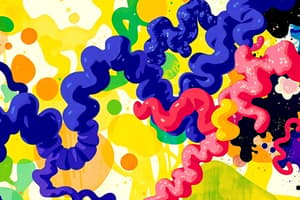Podcast
Questions and Answers
What is the key characteristic of fibrous proteins?
What is the key characteristic of fibrous proteins?
Fibrous proteins are elongated and insoluble, providing structural support.
How are globular proteins generally described in terms of solubility?
How are globular proteins generally described in terms of solubility?
Globular proteins are generally soluble in water.
What role do transport or carrier proteins play?
What role do transport or carrier proteins play?
Transport or carrier proteins transport ions or molecules in the body.
Which classification of proteins includes those that provide nutrition and store ions?
Which classification of proteins includes those that provide nutrition and store ions?
What are the two main categories of proteins based on composition?
What are the two main categories of proteins based on composition?
What distinguishes regulatory proteins from other types of proteins?
What distinguishes regulatory proteins from other types of proteins?
What type of proteins are involved in the contractile system?
What type of proteins are involved in the contractile system?
Define the term 'amphoteric' in the context of amino acids.
Define the term 'amphoteric' in the context of amino acids.
Why are enzymes categorized as enzymatic proteins?
Why are enzymes categorized as enzymatic proteins?
What is a prosthetic group in conjugated proteins?
What is a prosthetic group in conjugated proteins?
What characterizes nonpolar, aliphatic R groups in amino acids?
What characterizes nonpolar, aliphatic R groups in amino acids?
How do aromatic R groups differ from polar uncharged R groups?
How do aromatic R groups differ from polar uncharged R groups?
Describe the charge of positively charged (basic) R groups at pH 7.0.
Describe the charge of positively charged (basic) R groups at pH 7.0.
What is the general function of selenocysteine in proteins?
What is the general function of selenocysteine in proteins?
How do amino acids act as acids and bases in solution?
How do amino acids act as acids and bases in solution?
What role does a zwitterion play in the behavior of amino acids in solution?
What role does a zwitterion play in the behavior of amino acids in solution?
What differentiates negatively charged (acidic) R groups from polar uncharged R groups?
What differentiates negatively charged (acidic) R groups from polar uncharged R groups?
List two uncommon amino acids and their specific functions.
List two uncommon amino acids and their specific functions.
What are derived proteins and give two examples?
What are derived proteins and give two examples?
How do albumins and globulins differ in terms of solubility?
How do albumins and globulins differ in terms of solubility?
Explain the significance of the α-carbon in amino acids.
Explain the significance of the α-carbon in amino acids.
List the three-letter abbreviations for three common amino acids.
List the three-letter abbreviations for three common amino acids.
What are the five main classes of amino acids based on their R groups?
What are the five main classes of amino acids based on their R groups?
What was the first amino acid to be discovered and in what year?
What was the first amino acid to be discovered and in what year?
Describe the process of identifying the carbons in an amino acid.
Describe the process of identifying the carbons in an amino acid.
Why are amino acids, except glycine, optically active?
Why are amino acids, except glycine, optically active?
Flashcards
Fibrous Proteins
Fibrous Proteins
Elongated, insoluble proteins providing structural support.
Globular Proteins
Globular Proteins
Compact, generally water-soluble proteins with complex shapes.
Membrane Proteins
Membrane Proteins
Proteins embedded in cell membranes involved in transport, signaling & communication.
Enzymatic Proteins
Enzymatic Proteins
Signup and view all the flashcards
Structural Proteins
Structural Proteins
Signup and view all the flashcards
Transport Proteins
Transport Proteins
Signup and view all the flashcards
Simple Proteins
Simple Proteins
Signup and view all the flashcards
Conjugated Proteins
Conjugated Proteins
Signup and view all the flashcards
Contractile Proteins
Contractile Proteins
Signup and view all the flashcards
Regulatory Proteins
Regulatory Proteins
Signup and view all the flashcards
Derived Protein
Derived Protein
Signup and view all the flashcards
Amino Acid
Amino Acid
Signup and view all the flashcards
α-carbon
α-carbon
Signup and view all the flashcards
R-group
R-group
Signup and view all the flashcards
Enantiomers
Enantiomers
Signup and view all the flashcards
Chiral center
Chiral center
Signup and view all the flashcards
L-amino acids
L-amino acids
Signup and view all the flashcards
Protein classification (Solubility)
Protein classification (Solubility)
Signup and view all the flashcards
Aromatic R groups
Aromatic R groups
Signup and view all the flashcards
Polar, uncharged R groups
Polar, uncharged R groups
Signup and view all the flashcards
Positively charged (basic) R groups
Positively charged (basic) R groups
Signup and view all the flashcards
Negatively charged (acidic) R groups
Negatively charged (acidic) R groups
Signup and view all the flashcards
Zwitterion
Zwitterion
Signup and view all the flashcards
Amphoteric
Amphoteric
Signup and view all the flashcards
Diprotic Acid
Diprotic Acid
Signup and view all the flashcards
What is the function of 4-Hydroxyproline?
What is the function of 4-Hydroxyproline?
Signup and view all the flashcards
Study Notes
Biological Chemistry - Lecture 5: Proteins
- Proteins are classified by structure, function, composition, and solubility.
- Proteins are classified based on the following aspects:
- Structure (fibrous, globular, membrane)
- Function (enzymatic, structural, transport, nutrient/storage, contractile, defence, regulatory, toxic)
- Composition (simple, conjugated, derived)
- Solubility (albumins, globulins, prolamins, glutelins)
Protein Classification - Based on Structure
- Fibrous proteins: Elongated, insoluble, provide structural support (e.g., collagen, keratin, elastin)
- Globular proteins: Compact, generally soluble in water, complex shapes, perform diverse functions (e.g., enzymes, antibodies, hemoglobin)
- Membrane proteins: Embedded in cell membranes, involved in transport, signaling, and communication (e.g., ion channels, receptors)
Protein Classification - Based on Function
- Enzymatic proteins: Biological catalysts (e.g., urease, amylase, catalase, alcohol dehydrogenase)
- Structural proteins: Strengthening or protecting biological structures (e.g., collagen, elastin, keratin, fibroin)
- Transport or carrier proteins: Transport ions or molecules in the body (e.g., myoglobin, hemoglobin, lipoproteins)
- Nutrient or storage proteins: Provide nutrition to growing embryos and store ions (e.g., ovalbumin, casein, ferritin)
- Contractile and mobile proteins: Function in the contractile system (e.g., actin, myosin, tubulin)
- Defense proteins: Defending against other organisms (e.g., antibodies, fibrinogen, thrombin)
- Regulatory proteins: Regulate cellular or metabolic activities (e.g., insulin, G protein, growth hormone)
- Toxic proteins: Hydrolyse enzymes (e.g., snake venom, ricin)
Protein Classification - Based on Composition
- Simple proteins: Yield only amino acids during hydrolysis (e.g., albumins, globulins)
- Conjugated proteins: Consist of a protein part (apoprotein) and a non-protein component (prosthetic group) (e.g., glycoproteins, lipoproteins, metalloproteins)
- Derived proteins: Modified or degraded from their original form through chemical or physical processes (e.g., proteans, metaproteins, coagulated proteins, peptones)
Protein Classification - Based on Solubility
- Albumins: Water-soluble; coagulate when heated (e.g., blood plasma)
- Globulins: Insoluble in pure water, soluble in dilute salt solutions (e.g., blood, milk)
- Prolamins: Soluble in alcohol (e.g., gliadin in wheat)
- Glutelins: Soluble in acids or bases (e.g., wheat, rice)
Amino Acids
- General Structure: Amino group (-NH2), carboxyl group (-COOH), hydrogen atom (-H), and a variable side chain (R group), all bonded to a central carbon atom (α-carbon).
- Common Amino Acids: Twenty different amino acids commonly found in proteins.
- α-amino acids: All 20 common amino acids are α-amino acids.
- Chirality: Most amino acids exist as L-stereoisomers, in proteins.
- Classification by R group:
- Nonpolar, aliphatic
- Aromatic
- Polar, uncharged
- Positively charged (basic)
- Negatively charged (acidic)
Additional Amino Acids
- Importance of Uncommon Amino Acids: (e.g. 4-hydroxyproline, 5-hydroxylysine, 6-N-Methyllysine, γ-carboxyglutamate, Desmosine, Selenocysteine, Ornithine, Citrulline)
Amino Acid Behavior in Solution
- Zwitterions: In water, amino acids exist as dipolar ions called zwitterions.
- Ampholytic nature: Zwitterions can act as both acids (proton donors) and bases (proton acceptors).
- Diprotic nature: Amino acids are diprotic when fully protonated by having two groups (-COOH, -NH3+) that can yield protons.
Studying That Suits You
Use AI to generate personalized quizzes and flashcards to suit your learning preferences.




